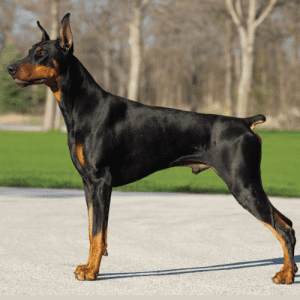
What Is The History Of The Doberman Pinscher Dog Breed?
The Doberman Pinscher dog breed is believed to have been developed in the late 19th century by a man named Louis Dobermann. Dobermann was a German tax collector who is thought to have used various breeds to create the ideal guard dog. The exact mix of breeds is unknown, but it is believed that the Rottweiler, Black and Tan Terrier, and Greyhound were all used in the development of the Doberman Pinscher. The breed was first recognized by the American Kennel Club in 1908.
Doberman Pinschers are known for their loyalty, intelligence, and bravery. They are often used as working dogs in various roles, including law enforcement, search and rescue, and service dogs. They are also popular pets, although their high energy level can make them challenging to train and care for.
What Does A Doberman Pinscher Dog Look Like?
Most Doberman Pinscher dogs have short, sleek hair that is Black, White, Fawn, Black & Rust, Red & Rust, Fawn & Rust, Blue & Rust, Blue, Red in color. Some may have small patches of white on their chests. The length of their hair does not require much maintenance, but regular brushing will help to keep it looking clean and healthy. These dogs do shed moderately throughout the year.
How Big Is An Adult Doberman Pinscher Dog?
The average size for a male Doberman Pinscher is 26 – 28 inches at the shoulder and 88-100 pounds. The average size for a female Doberman Pinscher is 24-27 inches at the shoulder and 71-77 pounds. There can be some variation in size within each gender, with some dogs being on the larger or smaller end of the spectrum. Generally speaking, though, Doberman Pinschers are considered to be a medium-sized breed.
Are There Other Dog Breeds Related To The Doberman Pinscher Dog?
A few other dog breeds are related to the Doberman Pinscher Dog. These include the American Staffordshire Terrier, Cane Corso, Dogue de Bordeaux, Pit Bull Terrier, and Rottweiler. These breeds share some similar physical characteristics with the Doberman Pinscher Dog, such as a muscular body type and large size. They also tend to be very loyal and protective of their families, making them excellent guard dogs.
What Is The Life Expectancy Of A Doberman Pinscher Dog?
The life expectancy of a Doberman Pinscher Dog is approximately 10-12 years. Like all breeds of dogs, there are health issues that can affect their lifespan. Some common health problems that Doberman Pinschers face include hip dysplasia, cardiomyopathy, and von Willebrand’s disease. While these conditions can shorten a Doberman’s life, with proper care and treatment, many dogs live long and happy lives.
Can A Doberman Pinscher Dog Be Trained?
Doberman Pinscher Dogs are very intelligent and easily trained. They can be taught to perform a variety of tasks and tricks. Some of the things a Doberman Pinscher Dog can be trained to do are sitting, staying, lying down, coming when called, heel, and shake. A Doberman Pinscher Dog can be a well-behaved and obedient pet with proper training.
What Are Some Interesting Facts About A Doberman Pinscher Dog?
- Doberman Pinscher Dogs are known for being fiercely loyal and protective of their family and home.
- The Doberman Pinscher Dog breed was originally developed in Germany during the late 1800s.
- Doberman Pinscher Dogs are considered to be one of the most intelligent dog breeds. They are often used as working dogs in various professions.
- The typical lifespan of a Doberman Pinscher Dog is 10-12 years.
- Doberman Pinscher Dogs are typically athletic and energetic and require plenty of exercise to stay healthy and happy.
How Does A Doberman Pinscher Dog Interact With People?
The Doberman Pinscher is a very loyal dog. They are protective of its family. It is important to socialize this breed of dog from a young age so that they are comfortable around people. These dogs need firm but loving leadership to thrive. They are intelligent dogs. They can be trained to do many things. The Doberman Pinscher is a great family pet that will bond with all family members. They are also excellent watchdogs and will protect their home and family from intruders.
